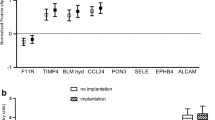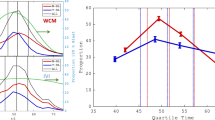Abstract
Purpose
We aimed to evaluate the link between the GDF9 concentration in day 3 human embryo culture medium and embryo quality and viability.
Methods
Two independent, prospective, observational studies were conducted. In study 1, a total of 280 embryos from 70 patients who obtained at least 4 embryos with 6–10 blastomeres (2 transferable and 2 non-transferable embryos) at day 3 were enrolled. In study 2, a total of 119 embryos from 61 patients (29 fully implanted and 32 non-implanted patients) were enrolled. The corresponding GDF9 concentrations in spent culture medium of embryos were quantified by ELISA assay. The expression pattern of GDF9 in human embryos was investigated using Q-PCR and immunofluorescence.
Results
GDF9 mRNA and protein were detected from human oocytes to eight-cell embryos and displayed a slow decreasing trend. In study 1, GDF9 concentration in culture medium is lower for transferable embryos compared with non-transferable embryos (331 pg/mL (quartiles: 442, 664 pg/mL) vs. 518 pg/mL (quartiles: 328, 1086 pg/mL), P < 0.001), and increased commensurate with the diminution of the embryo quality (P < 0.001). In study 2, significantly lower GDF9 concentration was detected for implanted embryos than non-implanted embryos (331 pg/mL (quartiles: 156, 665 pg/mL) vs. 518 pg/mL (quartiles: 328, 1086 pg/mL), P < 0.001). The same trend was found between the embryos that led to live birth and those that failed.
Conclusion
The GDF9 concentration in culture medium is linked to embryo quality and viability, and exhibited the potential to be a non-invasive biomarker for embryo selection.






Similar content being viewed by others
Availability of data and material
The datasets used and/or analyzed during the current study are available from the corresponding author on reasonable request.
Code availability
Not applicable.
References
Steptoe PC, Edwards RG. Birth after the reimplantation of a human embryo. Lancet. 1978;2(8085):366.
Ebner T, Moser M, Sommergruber M, Tews G. Selection based on morphological assessment of oocytes and embryos at different stages of preimplantation development: a review. Hum Reprod Update. 2003;9(3):251–62.
Racowsky C, Combelles CM, Nureddin A, Pan Y, Finn A, Miles L, et al. Day 3 and day 5 morphological predictors of embryo viability. Reprod Biomed Online. 2003;6(3):323–31.
Mantikou E, Youssef MA, van Wely M, van der Veen F, Al-Inany HG, Repping S, et al. Embryo culture media and IVF/ICSI success rates: a systematic review. Hum Reprod Update. 2013;19(3):210–20.
Kirkegaard K, Hindkjaer JJ, Ingerslev HJ. Effect of oxygen concentration on human embryo development evaluated by time-lapse monitoring. Fertil Steril. 2013;99(3):738-44 e4.
Lane M, Gardner DK. Embryo culture medium: which is the best? Best Pract Res Clin Obstet Gynaecol. 2007;21(1):83–100.
Alpha Scientists in Reproductive M, Embryology ESIGo. The Istanbul consensus workshop on embryo assessment: proceedings of an expert meeting. Hum Reprod. 2011;26(6):1270–83.
Capalbo A, Rienzi L, Cimadomo D, Maggiulli R, Elliott T, Wright G, et al. Correlation between standard blastocyst morphology, euploidy and implantation: an observational study in two centers involving 956 screened blastocysts. Hum Reprod. 2014;29(6):1173–81.
Rhenman A, Berglund L, Brodin T, Olovsson M, Milton K, Hadziosmanovic N, et al. Which set of embryo variables is most predictive for live birth? A prospective study in 6252 single embryo transfers to construct an embryo score for the ranking and selection of embryos. Hum Reprod. 2015;30(1):28–36.
Singh R, Sinclair KD. Metabolomics: approaches to assessing oocyte and embryo quality. Theriogenology. 2007;68(Suppl 1):S56-62.
Bromer JG, Seli E. Assessment of embryo viability in assisted reproductive technology: shortcomings of current approaches and the emerging role of metabolomics. Curr Opin Obstet Gynecol. 2008;20(3):234–41.
Botros L, Sakkas D, Seli E. Metabolomics and its application for non-invasive embryo assessment in IVF. Mol Hum Reprod. 2008;14(12):679–90.
Katz-Jaffe MG, McReynolds S. Embryology in the era of proteomics. Fertil Steril. 2013;99(4):1073–7.
Jones GM, Trounson AO, Vella PJ, Thouas GA, Lolatgis N, Wood C. Glucose metabolism of human morula and blastocyst-stage embryos and its relationship to viability after transfer. Reprod Biomed Online. 2001;3(2):124–32.
Gardner DK, Lane M, Stevens J, Schoolcraft WB. Noninvasive assessment of human embryo nutrient consumption as a measure of developmental potential. Fertil Steril. 2001;76(6):1175–80.
Gada RP, Daftary GS, Walker DL, Lacey JM, Matern D, Morbeck DE. Potential of inner cell mass outgrowth and amino acid turnover as markers of quality in the in vitro fertilization laboratory. Fertil Steril. 2012;98(4):863-9 e1.
Aaltonen J, Laitinen MP, Vuojolainen K, Jaatinen R, Horelli-Kuitunen N, Seppa L, et al. Human growth differentiation factor 9 (GDF-9) and its novel homolog GDF-9B are expressed in oocytes during early folliculogenesis. J Clin Endocrinol Metab. 1999;84(8):2744–50.
Juengel JL, Bodensteiner KJ, Heath DA, Hudson NL, Moeller CL, Smith P, et al. Physiology of GDF9 and BMP15 signalling molecules. Anim Reprod Sci. 2004;82–83:447–60.
Dong J, Albertini DF, Nishimori K, Kumar TR, Lu N, Matzuk MM. Growth differentiation factor-9 is required during early ovarian folliculogenesis. Nature. 1996;383(6600):531–5.
Gode F, Gulekli B, Dogan E, Korhan P, Dogan S, Bige O, et al. Influence of follicular fluid GDF9 and BMP15 on embryo quality. Fertil Steril. 2011;95(7):2274–8.
Li Y, Li RQ, Ou SB, Zhang NF, Ren L, Wei LN, et al. Increased GDF9 and BMP15 mRNA levels in cumulus granulosa cells correlate with oocyte maturation, fertilization, and embryo quality in humans. Reprod Biol Endocrinol. 2014;12:81.
Pennetier S, Uzbekova S, Perreau C, Papillier P, Mermillod P, Dalbies-Tran R. Spatio-temporal expression of the germ cell marker genes MATER, ZAR1, GDF9, BMP15, andVASA in adult bovine tissues, oocytes, and preimplantation embryos. Biol Reprod. 2004;71(4):1359–66.
Palomino J, Herrera G, Dettleff P, Martinez V. Growth differentiation factor 9 and bone morphogenetic protein 15 expression in previtellogenic oocytes and during early embryonic development of Yellow-tail Kingfish Seriola lalandi. Biol Res. 2014;47:60.
Xiong S, Han W, Liu JX, Zhang XD, Liu WW, Liu H, et al. Effects of cumulus cells removal after 6 h co-incubation of gametes on the outcomes of human IVF. J Assist Reprod Genet. 2011;28(12):1205–11.
Dyrlund TF, Kirkegaard K, Poulsen ET, Sanggaard KW, Hindkjaer JJ, Kjems J, et al. Unconditioned commercial embryo culture media contain a large variety of non-declared proteins: a comprehensive proteomics analysis. Hum Reprod. 2014;29(11):2421–30.
Montsko G, Zrinyi Z, Janaky T, Szabo Z, Varnagy A, Kovacs GL, et al. Noninvasive embryo viability assessment by quantitation of human haptoglobin alpha-1 fragment in the in vitro fertilization culture medium: an additional tool to increase success rate. Fertil Steril. 2015;103(3):687–93.
Zhu J, Li M, Chen L, Liu P, Qiao J. The protein source in embryo culture media influences birthweight: a comparative study between G1 v5 and G1-PLUS v5. Hum Reprod. 2014;29(7):1387–92.
Rodgaard T, Heegaard PM, Callesen H. Non-invasive assessment of in-vitro embryo quality to improve transfer success. Reprod Biomed Online. 2015;31(5):585–92.
Katz-Jaffe MG, Schoolcraft WB, Gardner DK. Analysis of protein expression (secretome) by human and mouse preimplantation embryos. Fertil Steril. 2006;86(3):678–85.
Montsko G, Godony K, Herczeg R, Varnagy A, Bodis J, Kovacs GL. Alpha-1 chain of human haptoglobin as viability marker of in vitro fertilized human embryos: information beyond morphology. Syst Biol Reprod Med. 2019;65(2):174–80.
Combelles CM, Holick EA, Racowsky C. Release of superoxide dismutase-1 by day 3 embryos of varying quality and implantation potential. J Assist Reprod Genet. 2012;29(4):305–11.
Stigliani S, Anserini P, Venturini PL, Scaruffi P. Mitochondrial DNA content in embryo culture medium is significantly associated with human embryo fragmentation. Hum Reprod. 2013;28(10):2652–60.
Stigliani S, Persico L, Lagazio C, Anserini P, Venturini PL, Scaruffi P. Mitochondrial DNA in day 3 embryo culture medium is a novel, non-invasive biomarker of blastocyst potential and implantation outcome. Mol Hum Reprod. 2014;20(12):1238–46.
Ramu S, Acacio B, Adamowicz M, Parrett S, Jeyendran RS. Human chorionic gonadotropin from day 2 spent embryo culture media and its relationship to embryo development. Fertil Steril. 2011;96(3):615–7.
Sher G, Keskintepe L, Fisch JD, Acacio BA, Ahlering P, Batzofin J, et al. Soluble human leukocyte antigen G expression in phase I culture media at 46 hours after fertilization predicts pregnancy and implantation from day 3 embryo transfer. Fertil Steril. 2005;83(5):1410–3.
Fisch JD, Keskintepe L, Ginsburg M, Adamowicz M, Sher G. Graduated Embryo Score and soluble human leukocyte antigen-G expression improve assisted reproductive technology outcomes and suggest a basis for elective single-embryo transfer. Fertil Steril. 2007;87(4):757–63.
Bouvier S, Paulmyer-Lacroix O, Molinari N, Bertaud A, Paci M, Leroyer A, et al. Soluble CD146, an innovative and non-invasive biomarker of embryo selection for in vitro fertilization. PloS one. 2017;12(3):e0173724.
Iles RK, Sharara FI, Zmuidinaite R, Abdo G, Keshavarz S, Butler SA. Secretome profile selection of optimal IVF embryos by matrix-assisted laser desorption ionization time-of-flight mass spectrometry. J Assist Reprod Genet. 2019;36(6):1153–60.
Ji H, Shi X, Wang J, Cao S, Ling X, Zhang J, et al. Peptidomic analysis of blastocyst culture medium and the effect of peptide derived from blastocyst culture medium on blastocyst formation and viability. Mol Reprod Dev. 2020;87(1):191–201.
Peng J, Li Q, Wigglesworth K, Rangarajan A, Kattamuri C, Peterson RT, et al. Growth differentiation factor 9:bone morphogenetic protein 15 heterodimers are potent regulators of ovarian functions. Proc Natl Acad Sci U S A. 2013;110(8):E776–85.
Yeo CX, Gilchrist RB, Thompson JG, Lane M. Exogenous growth differentiation factor 9 in oocyte maturation media enhances subsequent embryo development and fetal viability in mice. Hum Reprod. 2008;23(1):67–73.
Xue Z, Huang K, Cai C, Cai L, Jiang CY, Feng Y, et al. Genetic programs in human and mouse early embryos revealed by single-cell RNA sequencing. Nature. 2013;500(7464):593–7.
Sha QQ, Zheng W, Wu YW, Li S, Guo L, Zhang S, et al. Dynamics and clinical relevance of maternal mRNA clearance during the oocyte-to-embryo transition in humans. Nat Commun. 2020;11(1):4917.
Tadros W, Lipshitz HD. The maternal-to-zygotic transition: a play in two acts. Development. 2009;136(18):3033–42.
Baumann CG, Morris DG, Sreenan JM, Leese HJ. The quiet embryo hypothesis: molecular characteristics favoring viability. Mol Reprod Dev. 2007;74(10):1345–53.
Leese HJ. Quiet please, do not disturb: a hypothesis of embryo metabolism and viability. BioEssays. 2002;24(9):845–9.
Funding
This study was supported by the Chongqing Science and Health Joint Project (2021MSXM072); Special Research Project of Chongqing Health Center for Women and Children (2019YJMS01).
Author information
Authors and Affiliations
Contributions
J.L. conceived and designed the study. J.L. and C.L. performed the experiments. J.L., W.H., and F.X. collected the samples. C.L., J.Y., and Q.Z. performed the data statistics. J.L., X.L., and G.H. contributed to manuscript drafting with the help from all authors. All authors approved the final manuscript.
Corresponding authors
Ethics declarations
Ethics approval
This research was approved by the Institutional Review Board (IRB) of Chongqing Health Center for Women and Children (2019-RGI-05). All patients gave their written informed consent for culture medium analysis.
Conflict of interest
The authors declare no competing interests.
Additional information
Publisher's note
Springer Nature remains neutral with regard to jurisdictional claims in published maps and institutional affiliations.
The authors consider that Jingyu Li and Chong Li should be regarded as joint first authors.
Supplementary Information
Below is the link to the electronic supplementary material.
Rights and permissions
About this article
Cite this article
Li, J., Li, C., Liu, X. et al. GDF9 concentration in embryo culture medium is linked to human embryo quality and viability. J Assist Reprod Genet 39, 117–125 (2022). https://doi.org/10.1007/s10815-021-02368-x
Received:
Accepted:
Published:
Issue Date:
DOI: https://doi.org/10.1007/s10815-021-02368-x




